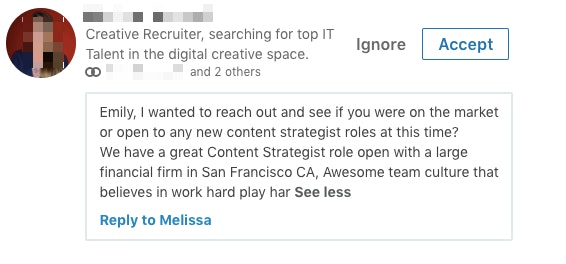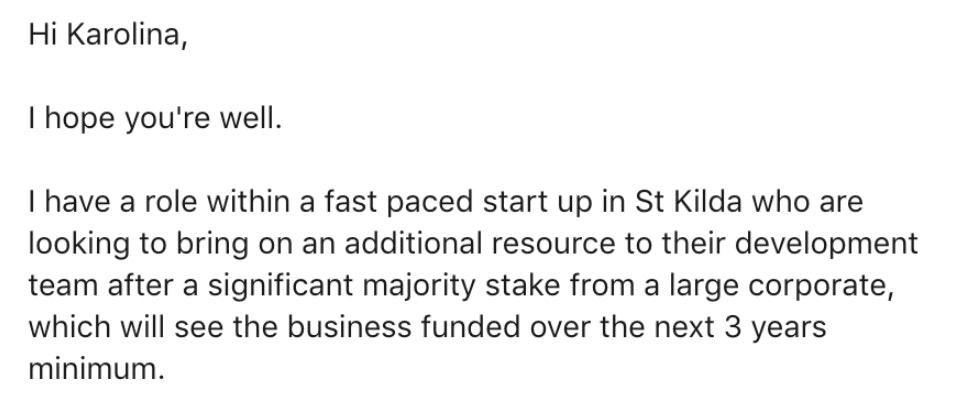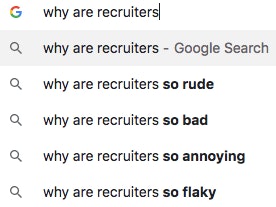If building an amazing team is critical to a company’s success, why is the bar so low for recruiting and hiring?
Plenty of us have received at least one horrible cold outreach email from a recruiter that’s made us lol, or applied to a position only to never hear from the company.
The research shows that the tech talent pool is small and competitive, and that companies must constantly evolve their benefits and culture to attract and maintain these niche skilled employees. So why are so many recruiting practices so terrible?

Even though this message cuts off mid-word, we think they’re trying to sell this company’s “work hard, play hard” culture as a plus … ? (Spoiler: It is not.)

Gotta love being referred to as a “resource.” Also, wow, this business has been funded, you say? Hot dang! Where do I sign up?!
In an industry obsessed with talking about the competitive nature of hiring, this kind of outreach shocks me every time.
At Help Scout, we have always prioritized in-house recruiting. What better way to attract new, amazing talent than with your current talent? We also don’t financially incentivize recruiting with shiny bonuses for filling seats (which often leads to many of these “spray and pray” outreach tactics). Still, the entire field of recruiting could use a refresher course in empathy — maybe then it wouldn’t suffer from one of the worst reputations in tech.

Thanks, Google.
I’m calling for us all to put the People back in People Ops. (Or HR, if that’s your fancy.)
6 tips for recruiting like a human
At a time when competition for excellent tech talent is stiff, everyone wants to know the secret sauce: How do you consistently hire skilled people who add value and remain mindful about building balanced, diverse companies — all while growing revenue?
At Help Scout, we build customer service software, so our customers are at the center of everything we do. When it comes to the hiring experience, our candidates are our customers, so that customer-first mindset naturally translates.
1. Great recruiting doesn’t require deep recruiting experience
While certainly many talented recruiters worked their way up through years of experience, it’s not the only pathway. The most essential tools in a recruiter’s toolbelt are emotional intelligence and great writing. Can you connect easily with strangers? Do you have empathy and understanding? Can you express both in a brief email? Great! You have the makings of a successful recruiter.
The best recruiters I have worked with came into the job as a second career: they can empathize with both the candidate and hiring managers, because they’ve been in their shoes. They can also see recruiting from outside of the recruiting perspective.
Heather Doshay
SVP of People at Rainforest QA
2. Center your recruiting strategy on diversity/inclusion best practices
The research is clear that balanced teams perform better and lead to more profitable companies, but it’s also the right thing to do — and diverse and inclusive teams make for a better and more exciting workplace for everyone.
Before recruiting anyone, think about the makeup of your teams, and run a demographic and inclusion survey so you have real data to work with. From this analysis, notice which teams are most homogenous — and focus your recruiting efforts there.
For us at Help Scout, our data showed us that our design and engineering teams were overwhelmingly white and male. We created a strategy to heavily target our sourcing efforts for qualified applicants from underrepresented groups in order to diversify our pipeline and have more balanced applicant pools. In 2016, only 5% of our Engineering/Design teams identified as women; today our engineering team is at 30%, and our product design team is 50% women. We still have a lot of work to do, especially across other axes of diversity than gender, but the strategy is getting us there.
3. Use your tools wisely
LinkedIn, for better or worse, is where just about every recruiter goes to start sourcing. Please go beyond LinkedIn! Pay attention to where people hang out and follow the chatter. Look for lists of who to follow (like this one and this one). See who those people follow, and then follow them, too. You follow?
I love Rocketreach for finding potential candidate emails. I also recommend getting familiar with targeted job sites and communities to attract wider candidate pools, such as Power to Fly, Tech Ladies, Women in Product, and POCintech.
An applicant tracking system like Lever makes sourcing and reaching out easier and more efficient. I can source candidates from LinkedIn and use a Chrome extension to add them into Lever, create nurture campaigns or set a “snooze” reminder to reach out to a candidate at a later date if now doesn’t make sense. Lever Nurture also tracks open and reply rates, which you should absolutely pay attention to! (If your message isn’t being opened, experiment with subject lines and rework what you’re saying. When people aren’t replying, show your email to a teammate and ask what else might entice them. Be open to experimentation and revision.)
4. Thoughtful recruiting is a long game
Recruiters who want instant gratification are in the wrong line of work. Successful recruiting is often a long game: It requires relationship building, patience and dedication.
Hey Tessa!
I'm baaack :) I just thought I’d check in again and see how you’re doing at X Company! We’re about to add another DevOps role and would still really love to have you and Megan, our Engineering coach, have a chat to learn more. Either way, I hope you’ve been well and would love to know what you’re up to.
Cheers,
Leah
Hi Leah,
Still very happy at X Company, but am starting to look into options that include full time remote work. So now is actually probably a good point to start that conversation. Let’s set up a conversation with Megan. :)
Tessa
(Ten emails and 1.5 years after initially contacting Tessa, we hired her.)
You may reach out to an awesome candidate, and they may be perfectly happy where they are at that moment. Make a note to circle back in three months to see if that’s still the case. The person who was once a happy teammate may now have one foot out the door, and you’ll have already left a positive impression, which will make it more likely they’ll be excited to chat with you.
5. Personalize your hiring outreach
If you’re only going to absorb one of these tips, let it be this one.
When was the last time you opened an email from a stranger? And when was the last time you read it all the way through and replied to them? If you’ve been on the receiving end of recruiter’s cold outreach, you know that exciting, personalized emails that make you want to write back are few and far between.
As an in-house recruiter at a company who prioritizes hiring at a reasonable pace (no hyper-growth, rocketship language around here), I have time to craft personalized cold outreach emails. And while AI and automation can offer benefits to talent acquisition teams, I’d argue that sending 10 personalized emails of substance to potential candidates will win out over 50 bland, boring, auto-filled messages any day.
It’s OK to use templates, but absolutely change them up for each person you reach out to. It shows you’re paying attention (and you should be). Don’t make it just about you — show them you’ve done your research about them and that you’re excited about them as a candidate.
Every time I reach out to a potential candidate, I imagine I’m reconnecting with an old friend whom I care about. I also think about how I work at an inspiring company that’s building a meaningful product to help people, alongside many brilliant, kind and humble teammates. Then I imagine the person I’m writing to needs to not only know this but believe it — all within the first few lines of my email. Piece of cake, right?
The tone of your email really felt personal, even how you described how to pronounce your name. It struck a chord with me that a person wrote this email and I felt guilty not getting back to Princess Leah! I answered your third email and I was intrigued because each touchpoint really felt thought out and like you did your research. I really did have the background for the role and I felt more confident responding for that reason!
Zainab Allawala
Help Scout Sales
At one point I was starting to feel I needed to look again since my contract was coming to a close, and your email just popped out because it was A) on the platform I was hoping to be contacted on — PowerToFly B) persistent and well written C) You mentioned Megan as the engineering coach which caught my attention since she is a woman and you did not repeat the same message again but added to the story you were trying to push across.
Kalina Spasova
Help Scout DevOps Engineer
Ask yourself what kind of email you’d want to receive, and then send that! Be friendly; make the message appealing and relevant to the person; cut to the chase; and ask to set up a meeting. Repeat.
6. Everyone gets a response
Maintaining an excellent candidate experience from start to finish is mission critical.
A major tenet of our hiring practice is that every person who enters our process, regardless of whether recruited them, receives a response. Whether it’s good or bad news, it’s essential we close the loop with candidates. Nobody likes to be ghosted, and responding with empathy and kindness in all cases builds trust in your company brand.
You’re only as good as your company culture
When you start crafting great outreach, you’ll find out fast if you have a great employer brand worth shouting about. Do you have well-written, interesting company blog posts that give meaningful insight into what it’s like working at your company? If not, why not? Do you have an inclusive “careers” page that shares your company’s values and mission that you can share with candidates to get them excited? Do you have meaningful benefits, like health care or remote work? All of these help make your cold outreach seem warm, engaging and genuine — and ultimately lead to responses and interested candidates.
You’re never going to excite anyone about your roles if your company is run by ego- or profit-driven leadership who doesn’t put customers and team members first. Recruiting outreach works when it offers a real opportunity to work at a special company. Most people won’t leave their current job unless it’s clear you are offering something better.
If you’re recruiting at your company and not getting the reply rates you’re hoping for, take a step back. Try partnering with design to refresh your careers page. Collaborate with marketing to produce an upbeat “about us” video that gives a realistic look behind the curtain at your company. Talk to your leadership team about assessing your benefits to make sure they’re going beyond perks. Create a company profile on GlassDoor and kindly suggest that employees leave honest reviews. Ensure your company’s mission and values are clearly stated and reiterated across all of your channels. And lastly, talk to your current teammates and ask them what makes working at your company special!
A standout company culture and the opportunity to work with great people is perhaps one of the greatest benefits you can offer. People want to work with lovely people — your recruiting outreach should reflect as much.







